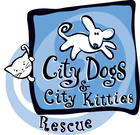The most successful potty training methods consist of four key elements:
- Confinement
- Training
- Praise
- Timing
Confinement
Dogs who don’t yet understand where it is appropriate to eliminate need to be confined in order to facilitate the easiest potty training. The best and most effective place to confine your foster dog is in a crate. If you do not have a crate, contact City Dogs Rescue to obtain the proper size crate. Most dogs will not eliminate where they live, therefore the crate needs to be large enough for your dog. Once you get your dog from their crate, immediately him/her take for a walk. This will get him/her into the habit of only going potty outside.
Training and Praise
Please keep in mind that most of our rescues have more than likely lived outside their entire lives and are not aware of the difference of going potty outside or inside. It’s up to us to teach them.
Some things to remember during potty training:
- Do not allow your dog to roam your home
- Keep an eye on your dog during training
When walking your foster dog, say things such as “go potty” or some other key word. When they go potty outside, reward lavishly and even provide a small treat. Remember when you choose your word or phrase, be consistent with it throughout training -you will be repeating it a lot!
As you take your dog outside on a leash right from the crate, start to teach him the word “outside”. Say things like, “Let’s go OUTSIDE!”, “Do you have to go ‘OUTSIDE?'”, or “OUTSIDE! OUTSIDE!” In time, the dog will learn that the word “outside” is associated with elimination. Eventually, you will be able to ask the dog “do you have to go OUTSIDE?” and get a response like barking, running to the door or tail wagging.
Timing
The best time for your dog to be taken outside to go potty is when you get him/her from the crate. Take your dog immediately for a walk after being in the crate, and say the command words “outside” and “go potty” once outside. Do not allow your dog to roam your home freely; this just teaches them to sneak away to eliminate.
Accidents
All is not lost if your dog eliminates in the house! If you catch him in the act, make an abrupt noise (clap hands and say “aaaaahhhh, aaaaaahhhhhh”) or use a firm, low voice to express your displeasure. The key is to stop him/her in the act, and then take immediately outside and say “go potty.” When your dog goes potty outside, reward by voice praise or small treat.
Remember, you must catch the dog in the act of inappropriate elimination to facilitate an effective lesson. Please don’t strike or push his nose in it, it does no good.
When will I know if my dog is housebroken?
Appropriate elimination first happens primarily because we, as owners, control it. When we potty train, we are working to establish a habit – and that usually takes 2 to 3 months, depending on how consistent and persistent you are as the owner/trainer.
Here are some indications your dog/puppy understands the program:
- Accidents in the house and/or crate have decreased during the training period to none or almost none.
- When you use your commands for elimination, your puppy responds by eliminating.
- Your dog starts to “ask” to go outside by barking, running to the door, staring at you, or however he/she chooses.
- The freedom you give your dog is mostly accident free.
Small Breeds and “Sneaking”
Some people say that small breeds can be difficult, if not impossible to potty train. This is not because they are stupid. They are actually rather smart – smart enough to sneak to places out of the way for them to make their deposits instead of asking to go outside. This just requires more vigilance on the owner’s part and less freedom for the dog. If necessary, the owner needs to attach the other end of the leash the dog is dragging to their belt loop to keep closer track of the sneak!
